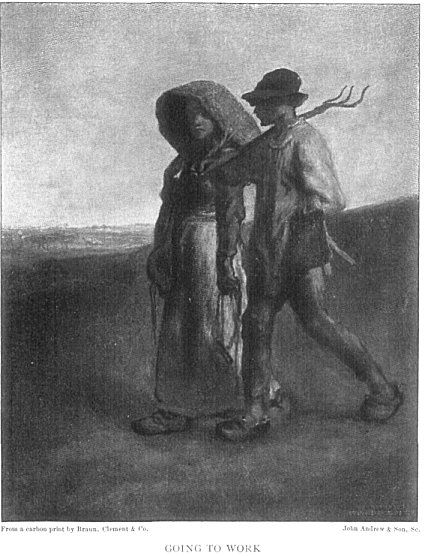








On the other side of the Atlantic Ocean, where the sea forms a narrow channel separating the British Isles from the European continent, lies that part of France known as the old province of Normandy. There is here a very dangerous and precipitous coast lined with granite cliffs. The villages along the sea produce a hardy race of peasants who make bold fishermen on the water and thrifty farmers on the land.
To this Norman peasant stock belonged Jean François Millet, the painter of the pictures reproduced in this little book. He was brought up to hard out-of-door labor on his father's farm in the village of Gréville, but when the artistic impulses within him could no longer be repressed, he left his home to study art. Though he became a famous painter, he always remained at heart a true peasant. He set up his home and his studio in a village called Barbizon, near the Forest of Fontainebleau, not many miles from Paris. Here he devoted all his gifts to illustrating the life of the tillers of the soil. His subjects were drawn both from his immediate surroundings and from the recollections of his youth. "Since I have never in all my life known anything but the fields," he said, "I try to say, as best I can, what I saw and felt when I worked there." It is now a quarter of a century since the painter's life work ended, and in these years some few changes have been made in the customs and costumes which Millet's pictures represented. Such changes, however, are only outward; the real life of peasant labor is always the same. Seedtime and harvest, toil, weariness and rest, the ties of home and of religion, are subjects which never grow old fashioned.
In France the farm labors are shared by men and women alike. The peasant woman is sturdily built, and her healthy out-of-door life makes her very strong. She is fitted by nature and training to work beside the men in the fields. In our first picture we see a young man and woman starting out together for the day's work.

It is morning, and the early sun illumines the distant plain, where ploughing has already begun. The light falls on the two figures as they walk down the sloping hillside.
They are dressed for their work in clothing which is plain and coarse, but which is perfectly suited for the purpose. The French peasants' working clothes are usually of strong homespun cloth, fashioned in the simplest way, to give the wearers entire ease in motion. They are in the dull blues, browns, and reds which delight the artist's eye. Such colors grow softer and more beautiful as they fade, so that garments of this kind are none the less attractive for being old. Ragged clothing is seldom seen among peasants. They are too thrifty and self-respecting to make an untidy appearance.
The men wear soft felt hats, the brim of which can be pulled forward to shade the eyes. The women cover their heads neatly with caps or kerchiefs, and are nearly always seen with aprons. Men and women both wear the heavy wooden shoes called sabots, in which the feet suffer no pressure as from leather shoes, and are protected against the moisture of the ground.
The peasants of our picture carry all they need for the day's work. A three-pronged fork rests across the man's shoulder, and a wallet of lunch hangs from his left arm. The woman has a basket, a linen sack, and a bit of rope. Evidently something is to be brought home. Just now she has swung the empty basket up over her shoulders and it covers her head like a huge sunbonnet.
The two young people are full of the healthy vigor which makes work a pleasure. They go cheerfully to their day's task as if they really enjoyed it. We cannot help suspecting that they are lovers. The man carries himself erect with a conscious air of manliness, and steps briskly, with his hand thrust into his pocket. The girl hides her shyness in the shadow of the basket as she turns her face towards his. The two swing along buoyantly, keeping step as if accustomed to walking together.
At the close of the day's work the basket and sack will be filled, and the laborers will return to their home by the same way. The burden may be heavy, but they will bear it as the reward of their toil.
The picture of Going to Work was painted at about the same time[1] as the The Sower, which forms one of the later illustrations of our collection. A comparison of the pictures will show interesting points of resemblance between the two men striding down hill. Though Going to Work is not as a work of art of equal rank with The Sower, we get in both pictures a delightful sense of motion which makes the figures seem actually alive.
[1]
That is, within a year. See dates in the Historical Directory.